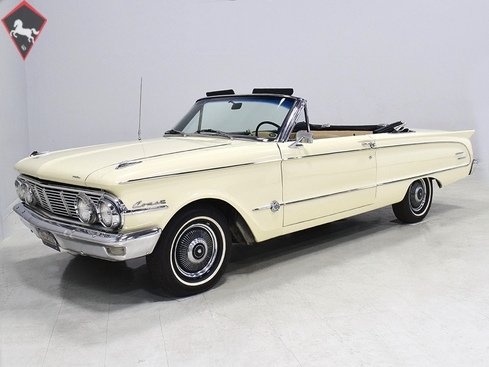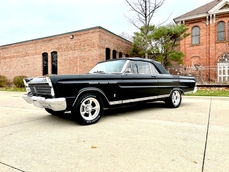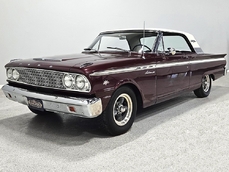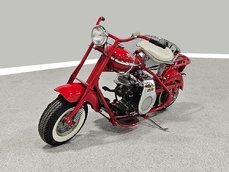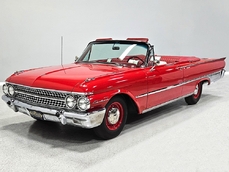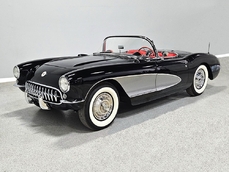Mercury Comet 200 cubic inch inline-6 1963
Allgemeine Beschreibung :
Nice older restoration. Original color combination. Great-running 170 cubic inch inline-6 with automatic, so it’s easy to handle. Power top, bucket seats, center console. Very clean throughout, ready to have fun!
Before there was the Mustang, the Ford Falcon and Mercury Comet were the go-to choices for right-sized cars that were fun to drive and affordable to own. The Comet was a bit bigger and more luxurious than the bare-bones Falcon and offered a unique look that sets it apart. For many people, it was a big step up, offering big car looks and comfort without the big car price tag. That remains true today, where you can own this awesome 1963 Comet convertible for less than the cost of a comparable Mustang. With small tail fins, the Comet has a look that ties it together with its other Mercury siblings and helps it stand apart—here in the showroom, a lot of folks mistake it for something bigger and more expensive. Mercury called code M Sultana White, which is pretty much the same Wimbledon White that adorned so many Fords of the era. It’s a soft white with a little yellow in it, not a hard appliance white, and that certainly helps with the upscale look. Finish quality is very good with straight bodywork that doesn’t show signs of major rust or accident damage, good panel gaps, and end caps on those tail fins that fit almost seamlessly. The chrome is probably original and some of it is showing some age, including the ‘Comet’ emblem on the hood, which is damaged, but details like the fluted panel between the taillights and both bumpers are in great shape, plus the distinctive S-22 stainless trim on the sides. For a car you’re going to drive, this one presents quite well.
The tan bucket seat interior was part of the S-22 package and it offers correct seat covers with silver piping, new black carpets, correct door panels, and plenty of 1960s jet-age details—check out the silver fil inserts on the door panels! These were simple cars, so the instrument panel reflects that: a wide speedometer, fuel and temperature gauges, and a row of control knobs for secondary functions underneath. The black plastic steering wheel is so nice it has to be new, and the controls will feel familiar the moment you slide behind the wheel. Affordable cars weren’t usually loaded up with options, although there’s an AM radio in the center of the dash and a power convertible top, something seldom seen on these cars. The top itself was probably replaced at the same time, and offers a crystal clear rear window and an excellent fit. There’s also a rather large trunk upholstered in correct mouse fur upholstery and it includes a full-sized spare tire assembly.
Ford’s remarkably smooth 170 cubic inch inline-6 provides enough power to make the Comet feel sporting around town. It never seems to work very hard and the inline engine remains turbine smooth throughout the range. Given it’s bulletproof reliability and easy maintenance, it remains a great choice for the enthusiast looking for a car that’s easy to live with. It’s detailed with Ford Blue engine enamel and wears correct decals and lots of new parts, including belts, hoses, fuel pump, and more. It starts easily and idles nicely, and never seems to be working very hard. The 2-speed Merc-O-Matic automatic transmission is a great complement to the six’s torque curve, pulling it off the line with enthusiasm yet reasonable at highway speeds. The undercarriage is clean with professionally-done floor patches in the usual spots, but nothing that should cause concern. The rockers and torque boxes are in excellent condition and all the factory convertible reinforcements are still in place. There’s a newer exhaust system with a pleasing sound, the brakes are effective, the gas tank is new, and it sits on factory steel wheels and 195/75/14 whitewall radials.
A little unusual, a lot of fun, and nicely finished, this Comet delivers the kind of drop-top fun you’ve been looking for. Cheaper than a Mustang and far less common, you’ll stand out at shows yet still benefit from the massive aftermarket that sprang up to support the Mustang—everything you will need is just a phone call away. A great little car that’s ready to enjoy. Call today!
Harwood Motors always recommends and welcomes personal or professional inspections of any vehicle in our inventory prior to purchase.
1963 Mercury Comet 200 cubic inch inline-6 is listed zu verkaufen on ClassicDigest in Ohio by Harwood Motors for $19900.
Fakten der Auto
Karosserietyp : Auto Marke : Mercury Modell : Comet Ausführung : 200 cubic inch inline-6 Hubraum : 0.0 Modelljahr : 1963 Karosstyp : Convertible Lage : Ohio Fahrzeug Anmeldung : Undefiniert
19900 $
People who viewed this Mercury Comet also viewed similar Mercury listed at ClassicDigest
Other cars listed for sale by this dealer
über Mercury
Mercury, die Automarke, hat eine reiche Geschichte, die über ihre Rolle in der Anpassungs- und Hot-Rodding-Szene hinausgeht, insbesondere mit dem ikonischen Mercury Eight. Hier sind einige wichtige Punkte über Mercury:Gründung und Frühe Jahre:
Mercury wurde 1938 von der Ford Motor Company als Mittelklassemarke eingeführt und positionierte sich zwischen den erschwinglichen Ford-Modellen und der Luxus-Lincoln-Reihe. Die Marke sollte die Lücke zwischen diesen beiden Segmenten füllen.
Mercury Eight:
Der Mercury Eight, eingeführt im Jahr 1939, ist vielleicht das bekannteste Modell in der Geschichte der Marke. Er zeichnete sich durch ein elegantes Design und einen leistungsstarken V8-Motor aus. Dieses Modell wurde für die Anpassung und das Hot-Rodding populär und hat einen bedeutenden Platz in der amerikanischen Automobilkultur eingenommen.
Kultur der Anpassung:
Der Mercury Eight mit seinem unverwechselbaren Design und einem relativ erschwinglichen Preis wurde zu einem Favoriten unter den Bauherren von maßgeschneiderten Autos. Er spielte eine entscheidende Rolle in der Entwicklung der Kultur der maßgeschneiderten Autos und Hot Rods, insbesondere in der Nachkriegszeit.
Lead Sleds und Anpassung:
Der Begriff "Lead Sled" wird oft mit stark angepassten Autos aus den 1940er und 1950er Jahren in Verbindung gebracht. Diese Autos, einschließlich des Mercury Eight, wurden oft mit tiefergelegten Aufhängungen, gekürzten Dächern und anderen stilistischen Veränderungen modifiziert. Lead Sleds waren ein herausragender Bestandteil der Kultur der maßgeschneiderten Autos, und der Mercury Eight war eine beliebte Wahl für solche Modifikationen.
Wohlstand der Nachkriegszeit:
In der Nachkriegszeit erlebte Mercury, wie viele andere amerikanische Automobilhersteller, einen Aufschwung der Popularität, als die Wirtschaft florierte. Die Marke trug zur Faszination für stilvolle und leistungsstarke Autos dieser Ära bei.
Entwicklung von Modellen:
Im Laufe der Jahre produzierte Mercury verschiedene Modelle und trug so zum Angebot von Ford bei. Einige bemerkenswerte Modelle sind der Mercury Monterey, der Mercury Comet und der Mercury Cougar.
Niedergang und Einstellung:
Trotz Phasen des Erfolgs hatte Mercury Schwierigkeiten, eine eindeutige Identität neben Ford zu etablieren. Mit dem Wandel der Verbraucherpräferenzen kämpfte die Marke, und Ford kündigte schließlich 2010 die Einstellung von Mercury an.
Erbe in der Populärkultur:
Mercury, insbesondere Modelle wie der Mercury Eight, nimmt einen bedeutenden Platz in der amerikanischen Populärkultur ein. Die Verbindung zur Szene der Anpassung und des Hot-Rodding sowie das unverwechselbare Design haben einen nachhaltigen Einfluss hinterlassen.
Zusammenfassend lässt sich sagen, dass der Mercury Eight für seine Rolle in der Kultur der Anpassung und des Hot-Rodding gefeiert wird, während Mercury als Marke eine breitere Rolle in der Automobilgeschichte spielte, indem sie zum mittelpreisigen Segment beitrug und die Automobil-Trends ihrer Zeit widerspiegelte.
